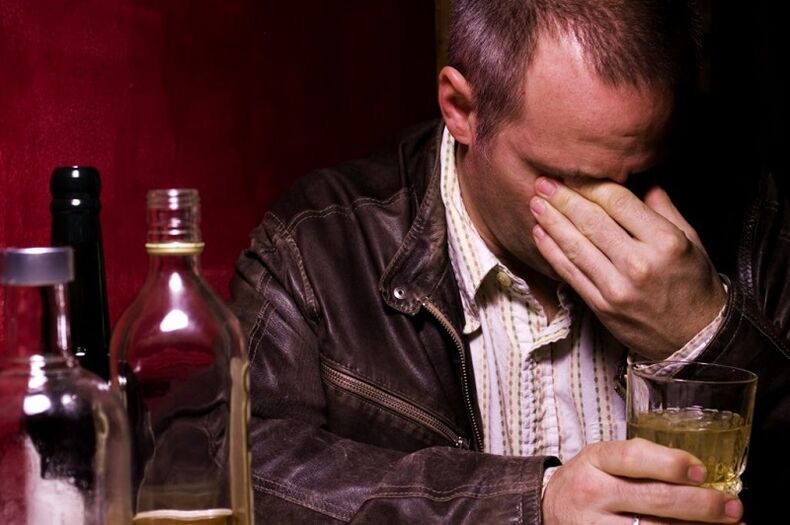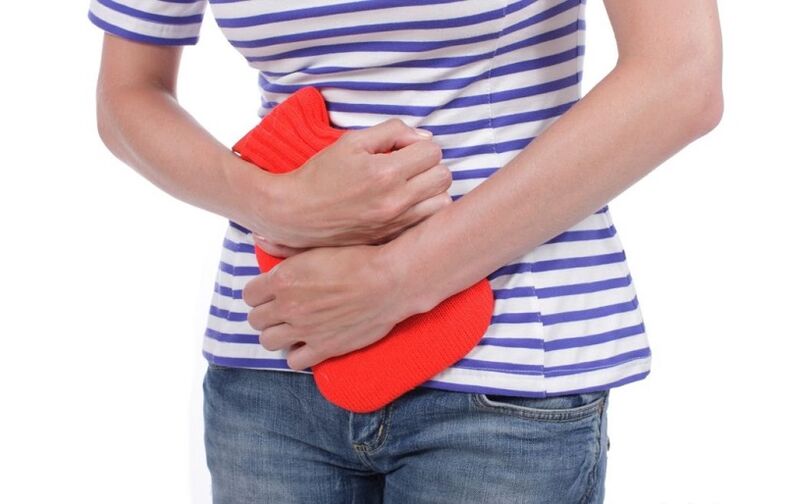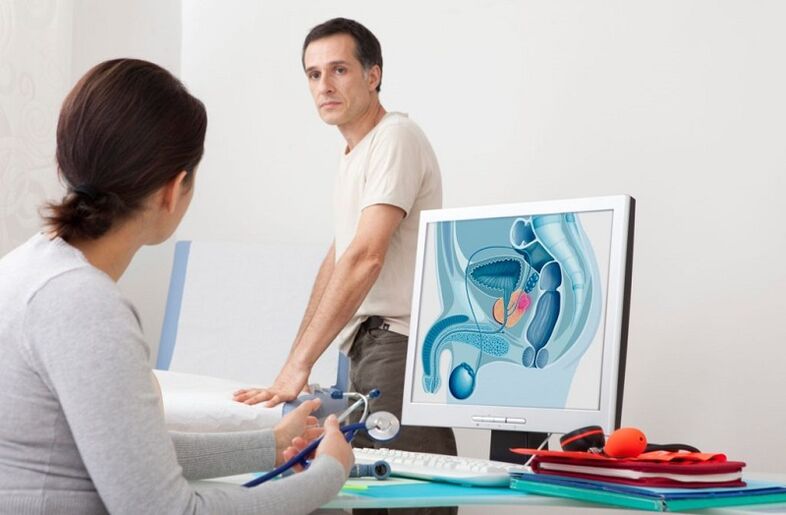Acute prostatitis is an infectious and inflammatory disease that covers the tissue of the prostate gland, causing extensive swelling and the appearance of purulent foci. The disease can manifest itself in different ways, depending on its stage of development. Therefore, an integrated approach is needed for accurate diagnosis. Treatment of acute prostatitis is most often done based on medication intake and physiotherapy techniques.
The reasons

Alcoholism can cause acute prostatitis.
The disease is most often transmitted in men over 30 years of age. In most cases, the disease develops due to the negative impact of pathogenic microflora on the male body. So, acute prostatitis in men can be triggered by the activity of the following microorganisms:
- Staphylococcus aureus;
- Pseudomonas aeruginosa and Escherichia coli;
- klebsiella;
- enterococcus;
- Proteus.
A large number of the above microorganisms are always present in the human body, while no inflammation is observed. If such bacteria enter the tissues of the prostate gland, then their active reproductive process begins, as a result of which severe inflammation develops in the prostate.
Bacterial penetration into the genitourinary system can occur during unprotected sexual intercourse. Therefore, it is very important for people who do not have a regular sexual partner to use condoms.
Inflammation can also be non -contagious, developing for the following reasons:
- obesity;
- inactive lifestyle;
- infrequent sexual intercourse;
- significant hypothermia;
- sexual dysfunction;
- eating disorders;
- smoking and alcohol abuse.
The above factors create fertile ground for the stagnation of prostate gland secretions. At the same time, stagnant blood processes are noted in vessels located in the area near the organ.
With the accumulation of abundant prostate secretions, a favorable environment will be produced for the reproduction of pathogenic microflora. As a result, the development of inflammatory processes occurs. The latter can cause a number of complications, such as:
- BPH;
- abscess;
- oncological process.
Important!With a background of acute prostatitis, most men have problems with potency and there is a risk of infertility.
Therefore, in the risk group for developing this disease are people who:
- there is no ordinary sex life;
- there is a lack of physical activity;
- there are bad habits.
Forms and levels

For any symptoms of prostate discomfort, you should immediately go to the hospital.
In modern medicine, there are three main stages of the disease. Let's consider it in more detail:
- The first stage is called catarrhal.It is characterized by the occurrence of primary inflammatory processes with the appearance of edema of glandular tissue, acini expansion. In this case, the prostate gland becomes enlarged. If the disease is not treated, then the inflammation gradually enters the excretory tract of the prostate gland, which is connected to the back of the urethra. With inflammation of the prostate duct, its narrowing and blockage gradually occurs, as a result of which the process of secretion of prostate secretions is quite difficult. At the catarrhal stage of its development, the inflammatory process covers only the mucous layer.
- This is followed by the follicular stage of the disease.It is characterized by the further development of the inflammatory process, in which the remaining organ tissues are gradually involved. As a result, acute forms of bacterial prostatitis develop. In the analysis of urine at the stage of development of the disease, there is pus. However, despite the damage to a large number of tissues, this form of follicular prostatitis responds well to treatment.
- The last rank is called parenchymal.It is characterized by destructive changes in the tissue of the prostate gland. At the same time, the swelling gradually grows, and the inflammatory process eventually covers the entire organ. If the development of the disease reaches this stage, then the process of treatment is very complicated, requiring radical measures. If there is no timely and adequate treatment, chronic prostatitis can develop.
In the early stages of the development of the disease, the subacute stage is usually differentiated. It is characterized by a weak sign severity, which is explained by low pathogenic activity. The disease can be at this stage for a long time if the patient’s body has good resilience. At the same time, it is very difficult to diagnose the disease at the subacute stage, which is why most patients do not get timely treatment.
Symptoms
Each form of the disease is characterized by its own symptoms. Therefore, you should consider it separately.
Catarrhal form

This form of the disease is characterized by a frequent urge to walk for little necessities.
If the infection has reached the excretory tract, then the stage of the disease develops. But even if the inflammatory process does not extend beyond the mucous membrane, the prostate gland becomes enlarged and swollen. In this case, the urethra is squeezed.
Symptoms of acute prostatitis at this stage are mild:
- due to duct compression, patients may notice minor problems with urination;
- at night, the urge to urinate becomes more frequent;
- the possibility of an increase in body temperature to 38 degrees;
- when the patient is in a sitting position, he may feel heaviness in the perineum.
In some cases, the catarrhal form occurs without severe hyperthermia.
The symptoms of the disease can disappear on their own after a few weeks after its development. And most patients in this case do not go to the doctor. However, this is fraught with the transition of the disease to a chronic state. Provided treatment of acute prostatitis is started on time, the disease will subside after 10 days.
Follicular shape
If the catarrhal stage has not been treated, then the disease progresses further, affecting the lobes of individual organs. In this case, significant symptoms appear:
- sharp pain observed during urination;
- the patient's body temperature is maintained around 38 degrees;
- dull pain appears in the perineum, which radiates to the penis;
- the process of urination is complicated;
- the patient has trouble defecating due to severe pain.
Since this stage is characterized by purulent prostate lesions, purulent threads can be seen in the patient’s urine. Provided that the therapy is carried out in a timely manner, complete healing of the disease at this stage occurs in less than two weeks after the start of the procedure.
Parenchymal form
It is also called diffuse. Since the inflammatory process covers the entire organ, the following symptoms occur:
- The pain of the perineum becomes almost unbearable. Periodically, they move to the glans penis. Some pain relief may occur in the supine position, when the patient presses both feet to the chest.
- Foreign body sensation in the rectum. There is significant pain in bowel movements. Constipation becomes more frequent, and if the inflammatory process turns into a reactive form, then the secretion of mucus begins from the anus.
- Serious problems during urination appear. In this case, partial and complete urinary retention is possible.
- Body temperature can reach 40 degrees. The patient suffers from chills.
Diagnostics

To make a definite diagnosis, several different studies are needed.
The disease is diagnosed by a specialist urologist who conducts a comprehensive study involving the following types of procedures:
- physical examination;
- instrumental research;
- laboratory research.
During the initial examination of the patient, the specialist throbs the glands. This must be done very carefully, avoiding massaging movements and strong pressure. Otherwise, you can cause significant discomfort to the patient.
The main diagnostic method is the study of the prostate gland, which is performed by introducing a probe into the rectum. This procedure allows the specialist to obtain the following data:
- determine the pain response;
- identify the main focus of destruction;
- confirm or deny signs of purulent tissue fusion;
- assess the shape of the organ and its symmetry, size and consistency.
As a rule, on palpation of the prostate, the secretions of this organ are highlighted. Its analysis allows you to accurately determine the presence of inflammatory processes. In the research, the number of leukocytes, amyloid bodies and other components were examined.
- urine bacterial culture and urethral removal with antibiotics;
- PCR scraping studies;
- sowing blood for blood culture.
The nature and severity of the underlying disorders in the acute process of the disease were assessed using uroflowmetry.
Ultrasound of the prostate gland with mild pain syndrome can be performed transrectally, and in cases of severe pain reactions - transabdominal. Ecoscopy, shape, size of the gland, the presence of focal or diffuse changes are assessed, the stage of the acute inflammatory process is determined.
When planning a surgical operation for a destructive form of acute prostatitis, it is recommended to perform an MRI of the pelvic area.
Disease treatment
The main method of treatment of acute prostatitis is etiotropic therapy. This is based on the timely indication of antimicrobial drugs to patients, which will prevent the development of pathogenic microflora on the pelvic organs. In addition to medications, patients are given treatment of folk remedies and physiotherapy procedures. A balanced diet plays an important role in the treatment of acute prostatitis.
Medications
Treatment of acute prostatitis should involve the elimination of the inflammatory infection. In addition, the task of therapy is to eliminate stagnation and normalize the circulatory process.
In most cases, outpatient treatment is used for patients with acute prostatitis. If the patient has some form of parenchymal disease, then he or she will be hospitalized.
The therapy of acute infectious prostatitis involves the administration of mandatory antibiotics. In this case, the duration of treatment is determined by the specialist, similar to the medication used.
Antibiotics from various groups are active against various microorganisms. That is why professional treatment is only done based on a thorough diagnosis. Therefore, doctors will be able to choose the right medication to fight a particular pathogen. Usually, treatment is carried out using drugs of this group:
- fluoroquinolones;
- penicillin;
- macrolide.
The first is considered the most effective. For this reason, they are most often used in the treatment of acute prostatitis.
Although antibiotics are the primary treatment, they are not the only medication used for acute prostatitis. In particular, patients were given antihistamines and intestinal -friendly bacteria.
At all stages of the treatment of acute prostatitis, it is very important to stimulate the immune system. For this reason, immunostimulatory drugs are prescribed to patients.
In addition to the above agents, interferon is used to treat acute prostatitis. It is possible to take such drugs in tablet form and by intramuscular injection. The latter option is considered better.
Physiotherapy
Under the conditions of proper selective drug treatment of acute prostatitis, the severity of the symptoms of the disease is significantly reduced. To combine the results obtained, the following physiotherapeutic techniques were used:
- Microwave and UHF therapy;
- rectal electrophoresis;
- prostate massage.
Folk remedies

Many experts argue that a cure for acute prostatitis using traditional medicine alone is impossible. In addition, the medications themselves can worsen the disease, leading to several complications. In this case, folk recipes can only be used in addition to official medicine. In addition, many pharmaceutical drugs are made from a variety of plants.
As a rule, with acute forms of prostatitis, patients are prescribed various infusions and decoctions. They should be drunk or used to get a healing solution while bathing. The most effective in this case are the following crops:
- chestnuts;
- mother and stepmother;
- the tail of a wild horse;
- Oak bark;
- chamomile.
Diet food
The key to curing acute prostatitis is a balanced diet. The inclusion of certain products in a patient’s weekly menu is based on the severity of his or her illness. However, regardless of the stage of the disease, the following foods should be excluded from the diet for a while:
- smoked meat;
- fried foods;
- conservation;
- strong tea and coffee;
- alcoholic beverages;
- spicy and salty foods;
- fish and fatty meats.
Prophylaxis

Sports activities are very useful for the prevention of prostate disease.
Prevention of acute prostatitis involves the timely elimination of inflammatory processes. To do this, it is necessary to treat bacterial, fungal and viral diseases in a timely manner. At the same time, any medical manipulations related to endourethral or endovesical examination must be performed subject to appropriate aseptic rules.
Effective prevention of acute prostatitis is based on the following principles:
- Strengthens the body's immune system.
- Genital hygiene.
- Have a regular sex life.
- Systematic physical activity and walking in the fresh air.
- Rejection of bad habits.
- Normalization of diet.
Regular prostate massage can be a good prevention against a number of urological diseases.
If you see the first signs of prostatitis, you should not hesitate - you should see a specialist as soon as possible. This will help cure the disease faster and prevent a number of negative consequences.




































